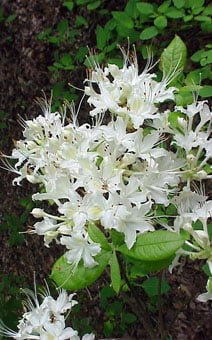
Rhododendron alabamense, commonly known as the Alabama azalea, is a
deciduous woody shrub in the Ericaceae
(Heath) family. It is native throughout most of Alabama in mixed hardwood forests
and hillsides. It is a midseason bloomer with strongly fragrant lemon-scented
white flowers with a prominent yellow blotch on the upper petal. Rhododendron alabamense is more drought tolerant than most of our other
native azaleas because it tends to grow in drier woodlands naturally, and may
colonize an area if conditions are favorable due to its stoloniferous nature. It was described as a new species in 1921 by
Alabama botanist, Charles Mohr, from plants found in Cullman County. The
Alabama Azalea often hybridizes naturally with Rhododendron canescens, the Piedmont azalea, since they have
overlapping bloom periods. This shrub grows best in part shade with average to
dry soils, and grows to 6-8 feet tall with loose, irregular branching. It
has a shallow fibrous root system so it does not tolerate routine soil
disturbance around the base (do not cultivate around the shrub). It pairs well
with Sourwood (Oxydendrum arboretum),
Flowering Dogwood (Cornus florida), Mapleleaf
Viburnum (Viburnum acerifolium), Purple
Anise (Illicium floridanum), American
Beautyberry (Callicarpa Americana), Oakleaf
Hydrangea (Hydrangea quercifolia), Mountain
Laurel (Kalmia latifolia), Christmas
Fern (Polystichum acrostichoides), Little
Brown Jug (Hexastylis arifolia), Virginia
Bluebells (Mertensia virginica), and
Perfoliate Bellwort (Uvularia perfoliata),
among others.

